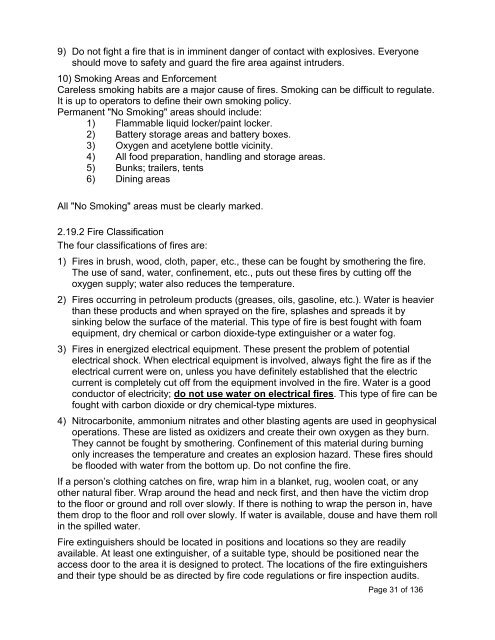IAGC LAND GEOPHYSICAL SAFETY MANUAL Edition 9 ... - CGISS
IAGC LAND GEOPHYSICAL SAFETY MANUAL Edition 9 ... - CGISS
IAGC LAND GEOPHYSICAL SAFETY MANUAL Edition 9 ... - CGISS
- No tags were found...
Create successful ePaper yourself
Turn your PDF publications into a flip-book with our unique Google optimized e-Paper software.
9) Do not fight a fire that is in imminent danger of contact with explosives. Everyoneshould move to safety and guard the fire area against intruders.10) Smoking Areas and EnforcementCareless smoking habits are a major cause of fires. Smoking can be difficult to regulate.It is up to operators to define their own smoking policy.Permanent "No Smoking" areas should include:1) Flammable liquid locker/paint locker.2) Battery storage areas and battery boxes.3) Oxygen and acetylene bottle vicinity.4) All food preparation, handling and storage areas.5) Bunks; trailers, tents6) Dining areasAll "No Smoking" areas must be clearly marked.2.19.2 Fire ClassificationThe four classifications of fires are:1) Fires in brush, wood, cloth, paper, etc., these can be fought by smothering the fire.The use of sand, water, confinement, etc., puts out these fires by cutting off theoxygen supply; water also reduces the temperature.2) Fires occurring in petroleum products (greases, oils, gasoline, etc.). Water is heavierthan these products and when sprayed on the fire, splashes and spreads it bysinking below the surface of the material. This type of fire is best fought with foamequipment, dry chemical or carbon dioxide-type extinguisher or a water fog.3) Fires in energized electrical equipment. These present the problem of potentialelectrical shock. When electrical equipment is involved, always fight the fire as if theelectrical current were on, unless you have definitely established that the electriccurrent is completely cut off from the equipment involved in the fire. Water is a goodconductor of electricity; do not use water on electrical fires. This type of fire can befought with carbon dioxide or dry chemical-type mixtures.4) Nitrocarbonite, ammonium nitrates and other blasting agents are used in geophysicaloperations. These are listed as oxidizers and create their own oxygen as they burn.They cannot be fought by smothering. Confinement of this material during burningonly increases the temperature and creates an explosion hazard. These fires shouldbe flooded with water from the bottom up. Do not confine the fire.If a person’s clothing catches on fire, wrap him in a blanket, rug, woolen coat, or anyother natural fiber. Wrap around the head and neck first, and then have the victim dropto the floor or ground and roll over slowly. If there is nothing to wrap the person in, havethem drop to the floor and roll over slowly. If water is available, douse and have them rollin the spilled water.Fire extinguishers should be located in positions and locations so they are readilyavailable. At least one extinguisher, of a suitable type, should be positioned near theaccess door to the area it is designed to protect. The locations of the fire extinguishersand their type should be as directed by fire code regulations or fire inspection audits.Page 31 of 136
















